






|
2014 |
 |
 |
 |
 |
 |
 |
 |
|
As you may know, I'm currently using two OM-D cameras: E-M5 and E-M1, therefore as much as I like the new E-M10, I don't really need one. Still, I have an old-time friend in Poland, who decided to upgrade to this model (his own idea, really!). As I am going to Poland for Easter, I was glad to offer help: getting an E-M10 in the States and bring it over (after checking that everything is fine with the camera). This turned out not so easy: the camera has been out of stock at B&H (my first choice) and Amazon for the last three weeks or so. Still, I kept checking both places twice a day, and the persistence paid off: I found three black E-M10 bodies listed at Amazon three days ago, about 7 PM, being sold by Ritz Camera. I snatched one, three hours later the others were gone as well. The next problem: my friend, being new to Micro Four Thirds does not have any compatible lenses. His needs are modest: he wants to start from a 14-42 mm and 40-150 mm zooms. While the latter is easily available (and now priced at just $150, which I consider a steal!), the 14-42 mm model IIR sells for $300 — quite unreasonable; as a part of the kit you can have it for just $100. | ||||||||||||||||||||||||||||
|
Solution: some dealers offer the updated mini-Pen, E-PM2, in a kit with both of these lenses at $400. This is less than the lenses purchased separately, and even if I charge my friend just $100 for the 14-42, I'm getting a respectable camera body for $150. While I'm not so enthusiastic about the Pen's ergonomics (or the missing eye-level finder), its imaging pipeline is the same (or very similar to) that of the E-M5, so having a spare body at this price looks very attractive. And yes, I may convert it to infrared. |
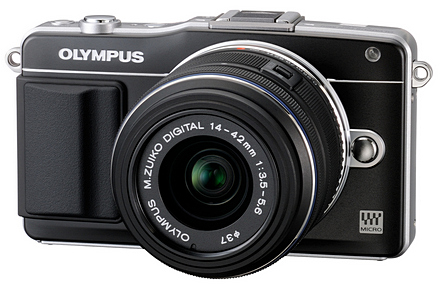
| |||||||||||||||||||||||||||
|
As a result, my buddy got the E-M10 with two kit lenses for the total of $950 (plus some extra for batteries, filters, and cards), and I ended up with the E-PM2 body at $150. I am now extensively using the former, just to see how it performs (and feels); as I am quite busy now, expect some follow-up early May... | ||||||||||||||||||||||||||||
|
I just packed the first batch of 500 slides to be scanned at the ScanCafe lab, I sent them to California, from there they go to Bangalore, India — so this will last at least two or three months. In the meantime:
Eight Kodak Carousel 140 trays, barely used, with original boxes, are looking for a loving home. Giving them away for free. Can split if you don't need the full set. Will ship UPS within U.S. and then tell you how much the shipping was. First come first served. Email me at
Looks like I know all I wanted to know about the E-M10, except for image quality, make and finish (just that!). I won't be able to put my hands on it for another month or so, so for the time being I will have to extrapolate from the company's track record. Anyway, the E-M10 Quick Notes article is done for now. The camera seems, indeed, to be a better E-M5, at least in some ways — it trades weather sealing for built-in flash and focus peaking, in addition to a reasonable cut in price; this seems to be a fair deal. For those who are shopping: if you really need splash-proofing, get an E-M5 within the next few weeks at a discounted price ($800 at B&H, body, and predicted to drop), otherwise you should be happy with the new model (unless Olympus did something quite unexpected with it). | ||||||||||||||||||||||||||||
|
2:30 AM: After uploading this page to the server at 2 AM and before going to sleep, I checked the official Web site of Olympus Poland (finding it better organized and less mass-market oriented than the Olympus US site). Lo and behold, the E-M10 has been officially announced, and I can see that the its pages are still being updated as I am writing this. | ||||||||||||||||||||||||||||
|
After a quick look at the spec sheet I'm getting an impression of the new camera being an incremental improvement to the E-M5 (not a downgrade as speculated a few days ago), with a built-in flash and WiFi added, plus a dozen or so minor changes.
No, I'm not going to give up my well-deserved sleep in order to rush in with an early write-up; no ambulance-chasing here. This can wait until tomorrow; for the time being, here is a nice promotional picture by Olympus. Keep salivating. |
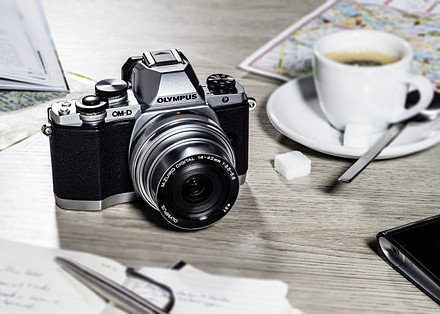
| |||||||||||||||||||||||||||
|
Fujifilm is getting serious about their mirrorless system cameras. They just announced the X-T1, as direct a competition to E-M1 as they come. The maker's press release and pictures provided show, indeed, another E-M1, literally and blow-by-blow. | ||||||||||||||||||||||||||||
|
Magnesium alloy body frame. Splash-, dust- and freeze-proofing. Imager phase-detection AF. Focus peaking. Viewfinder resolution and magnification: exactly like E-M1. Tilting monitor with one million dots. 16 Mpix APS-C sensor. Sounds familiar? What I really like about the camera is the direct interface to four basic settings: three marked top dials (shutter speed, exposure compensation, ISO) and lens aperture ring (on better lenses, that is). And, look, no mode dial! Set the shutter speed, aperture, or both (or even ISO) to the "A" position and done! Just like in Pentax cameras from the Seventies. There are also collar rings under two of the dials, controlling (probably) the drive mode and metering pattern. This means that six (!) settings can be changed without referring to the monitor screen. Hallelujah! At long last! The X-T1 and E-M1 look like designed by the same person (whom I already like!), they are similar in size and weight, and seem to be aimed at the same market. Except that Fuji aims in a more decisive way, not offending your intelligence with things like Art Effect Bracketing, Picture Story, and other, to put it mildly, i-diocies. Of course, the devil is in details. Without using the X-T1 or seeing some third-party image samples, my opinions have to be taken with a grain of salt. It is still possible that the camera will turn out to be a lemon. This is not likely, though, as its predecessors (X-E1 and X-E2) are solid cameras with good image quality, even if I don't like how they handle (seems like only now Fuji got that right). |
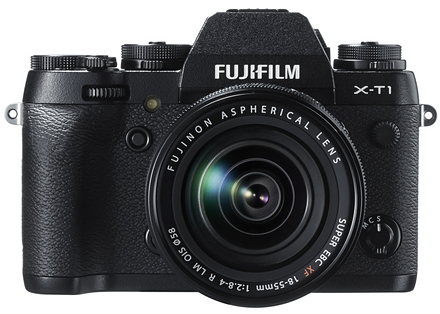
| |||||||||||||||||||||||||||
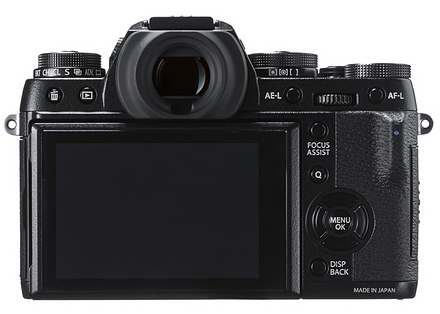
Promotional pictures © by Fujifilm | ||||||||||||||||||||||||||||
|
Assuming the X-T1 image quality turns out to be good, and with no ugly surprises in camera's operation, I expect at least some buyers to give up on the E-M1 and go the Fuji way ($1400 or so, body). Not surprising at all. If I haven't bought the E-M1 already, I would be facing a tough decision now. On the other hand, I must say that in the last ten years or so, whenever I'm trying out a non-Olympus camera, I discover some missing things I learned to take for granted. The grass may be not as green as it seems from the other side of the fence. Still, Fujifilm brings a new element to the competition, and that is good. I really wish them well. Correction: I just noticed that the dark noise article had a booboo: a switcheroo of camera names in two pairs of sample captions. Sorry. Fixed. | ||||||||||||||||||||||||||||
|
Dark Noise in the E-M5 and E-M1 is finished, with discussion, recommendations and conclusions added, in addition to a few more samples. | |
|
Happy New Year, everyone! I'm back from Poland (remember when flying was fun?), now freezing my behind off in Maryland, with water pipes bursting around the neighborhood, and abandoned cars in roadside ditches. I'm not sure I like this global warming thing... Picture of the Week: While in my maternal city of Łódź (say: woodzh), I was taken to a nice, small museum, the Herbst Palace, built by a 19th-century industrialist for his daughter. The main part, being the living interiors, has been lovingly restored, and the interior light is fairly dim — so the 12-40/2.8 lens was a perfect companion to the E-M5 set to ISO 6400 (!). I think I will make a small gallery from the Herbst Palace one day. |
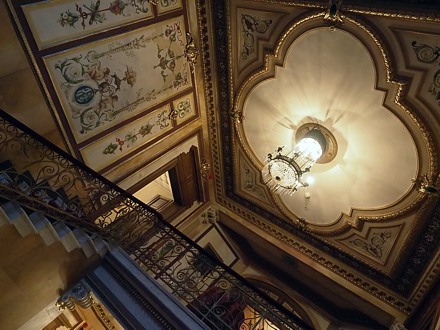
E-M1, 12-40/2.8 PRO at 12 mm |
|
About this lens: I am warming up to it. It is beautifully made, and may be optically better than the 12-50/3.5-6.3 (how much better I still don't know; have to find some time to check). What I especially like, is the focusing ring: pulling it back switches, right away, to manual focus mode, with the precise and old-fashioned mechanical coupling (no fly-by-wire here!). Push it away, and you are in AF again, all without moving your eye from the viewfinder or using the button/wheel combination. I just hope this solution will be used in more μFT lenses. | |
|
The Yellowstone Gallery page is finally done. Have a look. Most of it was shot with the E-M5, just three images came from the E-30. I found myself using the larger camera only when my wife took the E-M5 from me (which happened often, have to buy her a Stylus 1 to avoid that!), or when I needed the 70-300 mm lens. Yes, I did have the μFT 75-300/4.8-6.7 in the bag, but there were three reasons to use the FT setup: [1] limited trust in the other lens (wrongly!); [2] unwillingness to change lenses back and forth; [3] a need to get a longer reach with a teleconverter. Now that I'm using both the E-M5 and E-M1, I can carry the smaller body as a backup, or use it with the longer lens; there are some rumors (patent drawings) on the upcoming μFT teleconverter from Olympus, which would be nice. |
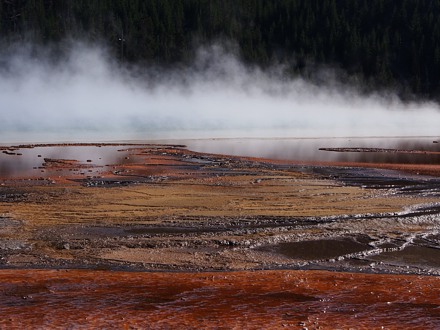
E-M5, MZD 12-50/3.5-6.3 at 48 mm |
|
My work on the E-M1 is slowly progressing: I just posted the samples for the Dark Noise in the E-M5 and E-M1 article. Still, there is lots of writing left, at least a week or so. While my analysis is still under way, I can already say that the E-M1 shows more dark noise at highest ISOs and longest exposures (above one second). For great majority of the camera users this is a non-issue (more on that when I finish the article). Even more interestingly, however, the new camera has a dramatically different dark noise pattern, a sign of major changes under the hood. Watch this space. | |
 |
 |
 |
 |
 |
 |
 |
| Home: wrotniak.net | Search this site | Change font size |
| Posted 2006/01/30; last updated 2014/03/26 | Copyright © 2006-2014 by J. Andrzej Wrotniak |